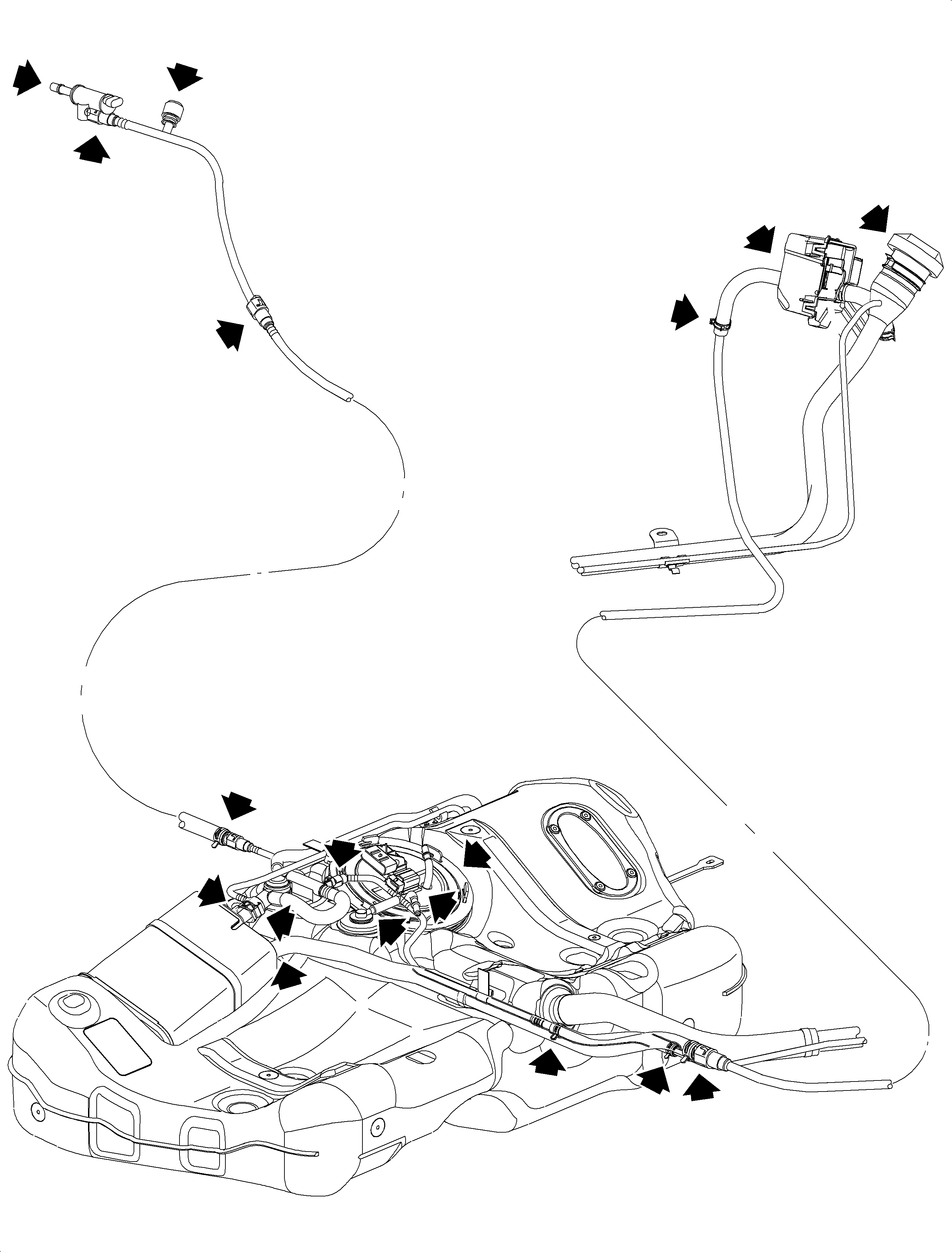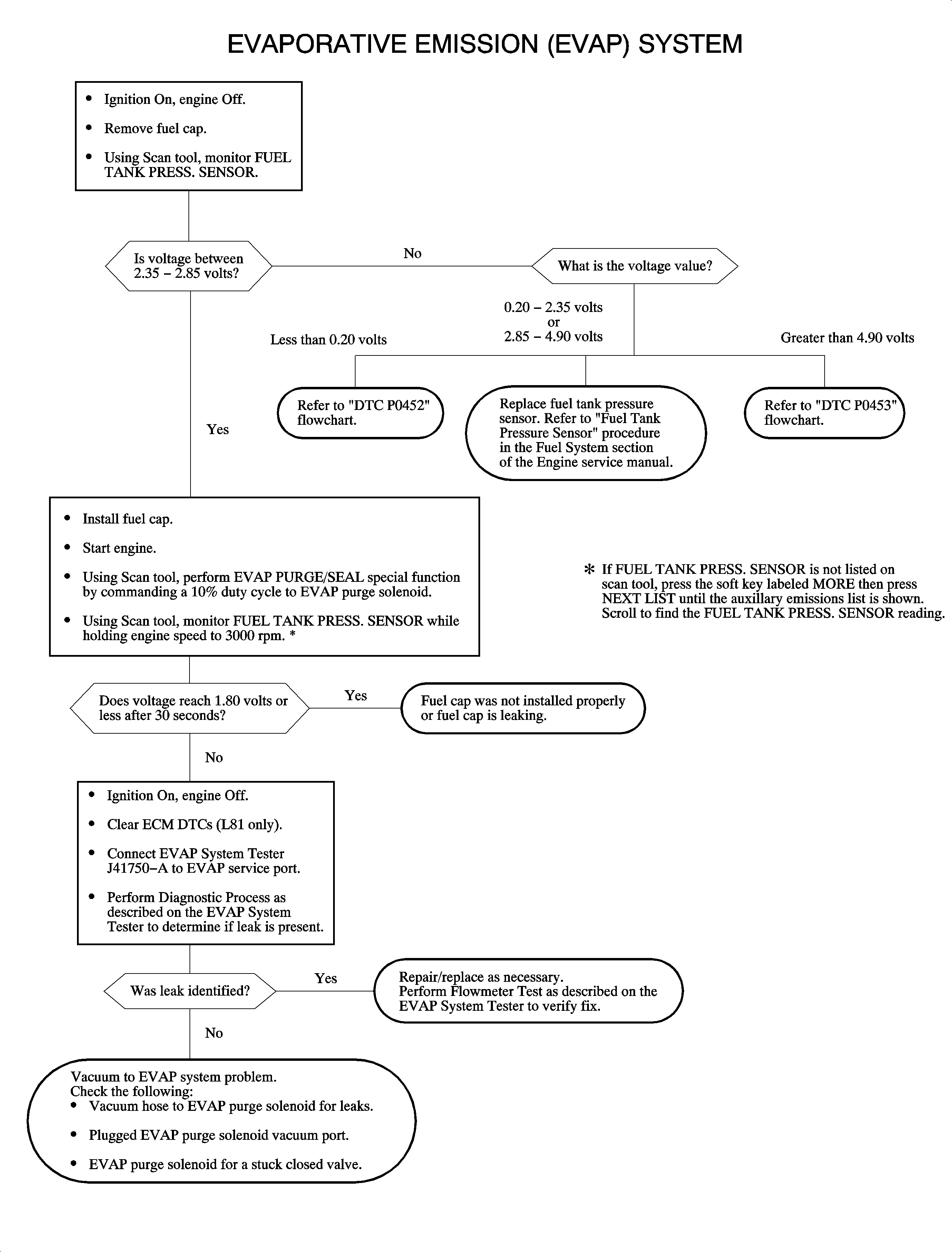The evaporative emission (EVAP) system is used to store fuel vapors as to reduce
the amount of unburned fuel from escaping into the atmosphere. The EVAP system consists
of the EVAP canister, fuel tank pressure sensor, EVAP lines and hoses, EVAP purge
solenoid (normally closed), EVAP service port, EVAP vent solenoid (normally open),
fuel tank, and PCM. The PCM monitors the EVAP system for circuit faults in the fuel
tank pressure sensor, EVAP purge solenoid, and EVAP vent solenoid circuits. The PCM
also monitors the EVAP system for small and large leaks. During DTC P0440,
the PCM monitors the fuel tank pressure sensor for an atmospheric pressure reading
when all of the DTC parameters have been met with the engine running. The PCM
will then command the EVAP vent solenoid ON (close valve) and command the EVAP purge
solenoid to a fixed duty cycle (pulses valve) with the engine running. The PCM will
let the pressure drop in the fuel tank for a certain length of time after which it
will turn OFF the EVAP purge solenoid. DTC P0440 sets when a certain vacuum
in the fuel tank could not be achieved due to a large leak.
DTC Parameters
DTC P0440 will set if fuel tank pressure voltage is greater than 1 volt
during the diagnostic test indicating a vacuum can not be pulled on the EVAP system
when:
| • | The condition exists for longer than 6 minutes and 40 seconds. |
| • | The EVAP vent solenoid is commanded ON (closed). |
| • | The EVAP purge solenoid is commanded to a fixed duty cycle (pulses valve). |
| • | The fuel tank level is between 15-85 percent. |
| • | The BARO is greater than 75 kPa. |
| • | The ECT and IAT at engine startup are between 4-30°C (39-86°F). |
| • | The ECT and IAT are within 8°C (46°F) of each other. |
| • | The TP angle is between 7-35 percent. |
| • | The vehicle speed is less than 113 km/h (70 mph). |
| • | No ECT, fuel tank pressure, IAT, MAP, HO2S-1, PCM internal fault, TP,
or vehicle speed DTCs have been set. |
DTC P0440 runs once per ignition cycle, usually for 30 seconds when no
faults exist, once the above conditions have been met. If this test fails, a warm
test will be performed and can only PASS a diagnostic test, not fail it. The purpose
of this test is to keep the MIL OFF during the initial test if the customer starts
the vehicle with the fuel cap off.
DTC P0440 runs once per ignition cycle once the above conditions have been met.
DTC P0440 is a type A DTC.
Diagnostic Aids
Important: The PCM uses the fuel tank pressure sensor to detect the amount of vacuum pulled
on the EVAP system during the leak diagnostic tests. Make sure the fuel pressure sensor
is not skewed by verifying the FUEL TANK PRESS. SENSOR on the scan tool is between
2.35-2.85 volts with the ignition ON and fuel cap removed.
Make a visual inspection for a large leak of the EVAP system. Use the Evaporative
Emission System tester to locate the large leak.
Possible causes of a large leak:
| • | The fuel cap is missing, incorrectly installed, or leaking. |
| • | The EVAP vent solenoid is stuck open. |
| • | The EVAP purge solenoid is stuck closed or blocked. |
| • | The EVAP vent hose is loose or damaged. |
| • | The EVAP canister is leaking. |
| • | The fuel sender assembly O-ring is leaking. |
| • | The fuel tank or filler neck is leaking. |
Refer to the following diagram which shows potential leak areas.




